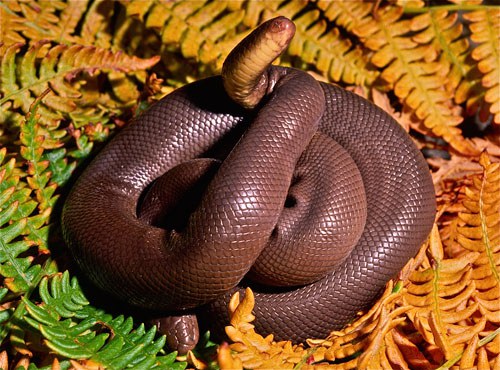Boas are the victims of bad press. Public perceptions about these snakes have been shaped by too many old, grade-B safari movies with plots revolving around one frightening jungle menace after another. Many directors seemingly can't resist using the image of an immense snake dropping from a tree to envelope some unfortunate actor in its deadly coils.
Don't automatically believe all snake-related depictions that you see in the movies. It's a lesser-known fact that there are also a number of small boa species. One is native to Central Oregon and most of the surrounding Pacific Northwest region, along with the wooded sections of California. This harmless little snake, which usually does not grow much beyond two feet in length, is called the rubber boa (scientifically known as Charina bottae). The common name is derived from the loose, rubbery quality of its smooth, olive-brown skin.
While its elastic skin alone would qualify it as unique, the rubber boa has a couple other quirky traits that make it one of the most intriguing of our native reptiles. 
One rather odd characteristic of this slow-moving, thick-bodied snake is the bluntly rounded tail that bears a remarkable resemblance to a secondary head. Consequently, the rubber boa is sometimes called the "two-headed snake" or "double-ender." The snake uses this fake head to its advantage when confronted by danger. Shy and retiring by nature, a rubber boa will not bite to protect itself. Instead, it simply rolls into a tight ball, hides its head beneath the coils of its body, and then displays the tail as a decoy "head." Occasionally, a rubber boa will even jab about with the tail, simulating a striking movement. In this way a predator is attracted to the more expendable tail, while the actual head is protected from harm. The tip of the tail features a large, solid scale plate that creates a protective hard cap to deflect the bites of attacking animals. Additionally, a bad-smelling musk is emitted to repel enemies.
Because most kinds of boas are tropical, the rubber boa bears the distinction of being the most northerly ranging of all its family. It reaches the limits of its distribution in mid British Columbia, Canada. Although rubber boas occur throughout all but the most arid deserts and damp, shady coastal rain forests of the Northwest, it's very secretive and rarely seen. Most of the daylight span is spent beneath logs and rocks, in rodent tunnels, or burrowing in leaf litter. As evening shadows lengthen or during cloudy mild weather, the little boa creeps from its hiding place to search for food. On warm summer nights it may continue to hunt throughout most of the nocturnal hours. The rubber boa eats a variety of small animals, including such items as lizards, other snakes, insects and nestling birds (it's a good climber), but the primary favored food source is small rodents. It's particularly fond of young mice that are still in the nest, using its all-purpose blunt tail to fend off attacks by mother mouse. In typical boa fashion, prey is subdued by constriction. Two or more loops of the snake's body are quickly wrapped tight around the victim, the intense compression causing death from suffocation and heart stoppage.
Like all other boa species, rubber boas are "live-bearing" (viviparous). One to eight young are born in the late summer or early autumn. Baby rubber boas are about seven inches in length and have a pleasing pinkish-tan hue. In fact, these dinky infant boas can sometimes initially be mistaken for a similarly colored earthworm.
Hiking in Deschutes Land Trust Preserves and just about anywhere else in the Bend area offers a possible encounter with a rubber boa. It inhabits not only the pine forested slopes of the Cascades (especially the borders of meadows where there are rotting logs for cover), but also eastward into the semi-arid juniper woodlands. Although not truly a desert reptile, rubber boas have been found in crevices at Fort Rock amid the sweeping sagelands.
Learning about this interesting and often overlooked animal can add a broader dimension to one's appreciation of the outdoors. Should you chance upon a rubber boa during your next jaunt along a trail, slow down for a close look and make a new acquaintance. Being slow-moving and non-flighty, probably no other snake is easier to get to know than our gentle little boa of the Northwestern woods.
Other Land Trust blog posts by Alan St. John:
About Alan St. John
A native Oregonian, Alan D. St. John lives in sage-scented juniper woodlands near Bend with his wife, Jan. Al is a freelance interpretive naturalist who uses writing, photography, and drawings to teach about the natural world. Specializing in herpetology, he has worked as a reptile keeper at Portland's zoological park, and conducted extensive reptile and amphibian field surveys for the Oregon Department of Fish and Wildlife, USDA Forest Service, the U. S. Department of the Interior's Bureau of Land Management, and the National Park Service. Along with authoring the books, Reptiles of the Northwest and Oregon's Dry Side: Exploring East of the Cascade Crest, his work has appeared in National Geographic, Outdoor Photographer, Ranger Rick, Natural History, Country, Nature Conservancy, The New York Times, and other periodicals.


